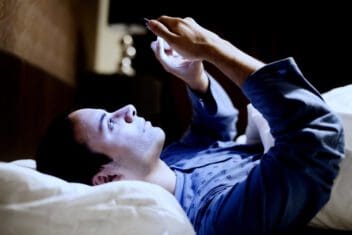Screen Time & Your Eyes: What the Research Says
Home / Vision Education Center /
Last Updated:
Does screen time affect vision? Most people know the sun can hurt our eyes but are less clear on whether to worry about other bright lights, like computer screens. In short, these screens are far less damaging than the sun.
Table of Contents
This is because screens aren’t as bright as the sun, and newer screens don’t generally produce UV rays, the most damaging kind of light the sun produces. Instead, the most important light to consider that screens produce is short wavelength, high-energy blue light.
In the short term, blue light is mostly associated with potentially causing eye strain. Per the American Optometric Association, this usually isn’t serious and can mostly be solved by habitually looking away from your screen on occasion and practicing some basic techniques to reduce the strain.
In the long term, some studies have suggested the blue light from screens can damage retinal cells, leading to problems like age-related macular degeneration. The extent of this issue is not fully understood, but it is notably not serious enough to suddenly avoid all use of screens.
Vision experts generally think screen time does not affect vision as a source of permanent damage, even if extended use can cause eye irritation. If you only look at screens for a few hours a day and don’t experience any vision issues, you probably do not need to worry.
The biggest thing to consider when it comes to screens is if and how much they may damage our eyes in the long term. There is not yet a fully clear answer, so more research needs to be done. The accepted view is that the blue light from screens is not a major cause of long-term vision issues, though excessive use should be avoided.
Does Screen Time Affect Vision?

Many people are understandably under the impression that any bright light aimed at our eyes can cause permanent damage. After all, the sun is one of the brightest things we encounter on a regular basis, and it is well understood that it can damage our eyes.
In some respects, it makes sense to think that even light sources that are not as bright, such as computers and smartphone screens, might damage our eyes too, given enough time. This is somewhat true, although not to the degree many assume.
The sun produces a wide spectrum of light rays. Its white color comes from the fact that it is producing red, orange, yellow, green, blue, indigo, and violet light all at once. Importantly, it also produces ultraviolet (UV) rays, which are invisible but can readily cause permanent damage if you’re exposed to them for lengthy periods of time. While skin damage from UV light is often discussed, the sun’s rays can also damage the eyes.
Old cathode ray screens (now almost completely obsolete and no longer used by the bulk of people) actually produced a tiny amount of UV rays when in use, but newer screens do not. The most troublesome light our modern devices (ranging from light bulbs to tablets) tend to produce is blue light.
This type of light has short wavelengths and relatively high amounts of energy. While blue light is not extremely dangerous and comes in far higher quantities from the sun, there is at least one study suggesting that long-term exposure to blue light through our devices may cause at least some eye harm.
The Short-Term & Long-Term Harm of Screens
In the short term, staring at screens for a long time is known to sometimes cause computer vision syndrome, or digital eye strain. While not serious, this condition can still be irritating and even detrimental to one’s work. It can potentially cause:
- Painful headaches.
- Eye strain.
- Blurred vision.
- Dry eyes.
You deserve clear vision. We can help.
With 135+ locations and over 2.5 million procedures performed, our board-certified eye surgeons deliver results you can trust.
Your journey to better vision starts here.
Digital eye strain is not just caused by exposure to blue light; it’s caused by a combination of factors.
The first factor is simply the length of exposure. The average American worker spends at least seven hours in front of a screen, and some people spend significantly more time than that staring at screens. Compounding the issue is the fact that many people are unfortunately in the habit of maintaining bad posture while staring at screens.
To avoid computer vision syndrome:
- Take a look at one of the many charts and articles online discussing how to properly sit at a computer. Posture and proper distancing from your computer can really help to reduce eye strain. While you may not notice an immediate difference, you’ll feel the effects of good posture and ergonomics over time.
- Try to light your workspace (or wherever you’ll be looking at a screen) properly, so the light level in the room is roughly equal to how much light your screen will be producing. Contrasting levels of light, such as being in a dark room while looking at a bright screen, can strain the eyes faster.
- Practice the 20-20-20 rule. This simple rule can help with eye strain. All you need to do is take a break every 20 minutes or so to stare at an object about 20 feet away for at least 20 seconds. This helps to give your eyes a break from focusing on a bright screen that is close to you. Make this rule a habit, and you’ll feel the difference in your eyes over time.
The effect of digital eye strain or screen time is the same whether you are using a computer, smartphone, or tablet since they all emit similar rays and have comparable effects on the eyes.
While computer vision syndrome or digital eye strain is almost always temporary, some individuals start to experience lingering problems if they continually experience it and do nothing to mitigate their symptoms. If you really struggle with this problem, talk to an eye doctor about the best solution for you to avoid more serious eye problems in the future.

Screens may be causing a subtler and less understood long-term problem. This was brought to light in studies that suggested sustained exposure to blue light could lead to impaired retinal cells. This has been linked to problems like age-related macular degeneration (AMD), which can cause blurred vision. There is no cure for AMD, but the condition can be managed.
There are some things you can do to protect your eyes from blue light. The most obvious is to simply reduce screen time. Some evidence suggests children’s eyes absorb more blue light than adults’ eyes. Children should have less screen time than adults.
There are filters and special glasses that are designed to reduce how much blue light is hitting your eyes. Many of these filters can also help with eye strain, as they reduce how bright your screen is compared to the rest of the room. You can benefit from wearing these glasses or using the filters for at least a few hours of your time in front of a screen each day.
Working From Home
With more people working from home than ever before in 2021 and beyond, screen time is way up for many.
If you work from home, all in-person meetings are replaced with Zoom or other video meetings, which means you are staring at a screen for many more hours than you used to in an average day.
Remember to take frequent screen breaks throughout the day by looking away from your computer. Actually get up to walk around for 5 minutes or so. Your body needs the break as much as your eyes.
You may also consider muting notifications on your other devices, like your phone or tablet. This allows you to truly take breaks while you eat meals or after hours, ensuring that you aren’t chained to your screens even if you are working from home.
You deserve clear vision. We can help.
With 135+ locations and over 2.5 million procedures performed, our board-certified eye surgeons deliver results you can trust.
Your journey to better vision starts here.
Screen Time for Kids
The COVID-19 pandemic greatly increased screen time for many kids, thanks to online school and limited in-person social interactions with friends. And screen time was already a subject of concern for many parents.
While all screen time is not bad for kids, it’s a good idea to encourage your children to avoid excessive screen time. Too much screen time has been linked to obesity, poor sleep patterns, low self-esteem, and behavioral problems.
Here are some tips:
- Put a daily time limit on screen time, and make that time limit clear. Generally, a max of 1 to 2 hours is recommended.
- Set up no-device areas, like the dining room and kitchen, where no one (adults included) can use their devices.
- Don’t allow devices in bedrooms. This can help to protect solid sleep schedules.
- Don’t eat in front of screens.
- Watch screens together. Make it a chosen family activity rather than a mindless individual one.
How Concerned Should You Be?
If you don’t notice much eye strain or other issues after extended computer or smartphone use, you probably don’t have anything to worry about. Staring at a screen is certainly nothing like staring at the sun. If you only use screens for a few hours a day, it’s unlikely you’ll ever experience any screen-related vision problems.
The biggest concern is just how much blue light may be contributing to age-related macular degeneration. Macular degeneration is not curable and can lead to blindness, but it also is not life-threatening and can be treated. While the condition won’t go away, it can be managed so it progresses slowly. Most people with AMD are able to manage its progression, so they maintain some level of good vision for many years.
Blue light is not the sole cause of age-related macular degeneration. It is caused by a combination of many factors. If you believe you are at risk of AMD, it can be helpful to limit your screen time.
An exact number on the amount of ideal screen time is tough to pinpoint. Most vision experts aren’t too concerned that screens cause much permanent damage (if any damage at all), but in some cases, screens can cause discomfort or potentially more serious problems.
Ultimately, it isn’t healthy to stare at a screen for hours on end. Excessive screen time brings various other concerns, other than just vision-related problems. Extended use of screens has been linked to various health issues, including obesity and insomnia.
Overall, limiting your screen time to a few hours a day and practicing the 20-20-20 rule should be enough to avoid any major vision problems related to screen time.
You deserve clear vision. We can help.
With 135+ locations and over 2.5 million procedures performed, our board-certified eye surgeons deliver results you can trust.
Your journey to better vision starts here.
References
- Blue Light and Your Eyes. Prevent Blindness.
- Digital Devices and Your Eyes. Prevent Blindness.
- Computer Vision Syndrome. American Optometric Association (AOA).
- Proper Sitting Posture at a Computer (According to Experts). (April 2019). Ergonomic Trends.
- What Is Macular Degeneration? (May 2019). American Academy of Ophthalmology.
- Research Progress About the Effect and Prevention of Blue Light on Eyes. (2018). International Journal of Ophthalmology.
- How to Deal With Screen Time Overload While Working From Home. (August 2021). CNBC.
- Screen Time and Children. (February 2020). American Academy of Child & Adolescent Psychiatry.
This content is for informational purposes only. It may have been reviewed by a licensed physician, but is not intended to serve as a substitute for professional medical advice. Always consult your healthcare provider with any health concerns. For more, read our Privacy Policy and Editorial Policy.
